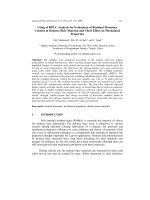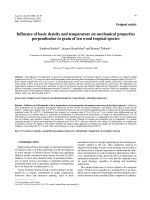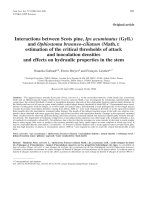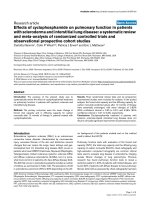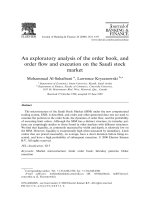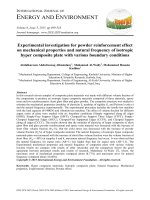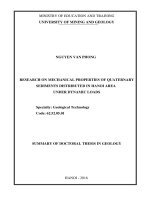Analysis of microstructural effects on mechanical properties of copper alloys 2017 Journal of Science Advanced Materials and Devices
Bạn đang xem bản rút gọn của tài liệu. Xem và tải ngay bản đầy đủ của tài liệu tại đây (8.83 MB, 12 trang )
Journal of Science: Advanced Materials and Devices 2 (2017) 128e139
Contents lists available at ScienceDirect
Journal of Science: Advanced Materials and Devices
journal homepage: www.elsevier.com/locate/jsamd
Original Article
Analysis of microstructural effects on mechanical properties of copper
alloys
Mitsuhiro Okayasu a, *, Takuya Muranaga a, Ayana Endo b
a
b
Graduate School of Natural Science and Technology, Okayama University, 3-1-1 Tsushimanaka, Kita-ku, Okayama, 700-8530, Japan
Department of Materials Science and Engineering, Ehime University, 3 Bunkyo-cho, Matsuyama, Ehime, 790-8577, Japan
a r t i c l e i n f o
a b s t r a c t
Article history:
Received 16 November 2016
Received in revised form
17 December 2016
Accepted 22 December 2016
Available online 30 December 2016
With the aim of obtaining copper alloys with favorable mechanical properties (high strength and high
ductility) for various engineering applications, the microstructural characteristics of two conventional
copper alloys d an aluminum bronze (AlBC; CueAl9.3eFe3.8eNi2eMn0.8) and a brass (HB: CueAl4eZn25
eFe3eMn3.8) d and a recently developed aluminum bronze (CADZ: CueAl10.5eFe3.1eNi3.5eMn1.1eSn3.7),
were controlled by subjecting the alloys to two different processes (rolling and casting) under various
conditions. For the rolling process, the rolling rate and temperature were varied, whereas for the casting
process, the solidification rate was varied. Microstructural characteristics, as examined by electron
backscatter diffraction analysis, were found to differ among the alloys. Complicated microstructures
formed in CADZ led to high hardness and high tensile strength (sUTS), but low ductility (εf). For CADZ,
casting at a high solidification rate allowed an increase in ductility to be obtained as a result of finegrained structure and low internal stress. In contrast, high ductility (with a fracture strain of more
than 30%) was found for both cast AlBC and cast HB; moreover, both of these alloys possessed high
tensile strength when produced by warm rolling at 473 K. For CADZ, on the other hand, no clear effect of
rolling on tensile strength could be found, owing to the many microcracks caused by its brittleness. The
results of this study indicate that copper alloys with excellent mechanical properties can be produced.
This is especially the case for the conventional alloys, with a high tensile strength sUTS ¼ 900 MPa and a
high fracture strain εf ¼ 10% being obtained for warm-rolled brass.
© 2016 The Authors. Publishing services by Elsevier B.V. on behalf of Vietnam National University, Hanoi.
This is an open access article under the CC BY license ( />
Keywords:
Bronze
Brass
Strength
Ductility
Microstructural characteristics
1. Introduction
Copper alloys, including bronzes, are currently employed in a
wide range of engineering applications because of their high
ductility, high corrosion resistance, non-magnetic properties,
excellent machinability, and high hardness [1]. Copper is used for
electric wiring and in heat exchangers, pumps, tubing, and several
other products, while aluminum bronze and high-strength brass
are found in marine applications, for example in propellers and
propeller shafts [2]. Furthermore, shiny brass is widely employed
for coins and for musical instruments. However, in spite of their
excellent material characteristics, there is still scope for technical
improvements to increase the strength and ductility of these alloys.
To achieve improvements in mechanical strength, several copper
* Corresponding author. Fax: þ81 86 251 8025.
E-mail address: (M. Okayasu).
Peer review under responsibility of Vietnam National University, Hanoi.
alloys with high dislocation density and fine microstructure, containing solid solutions, have been proposed. The mechanical
strength of ultrafine-grained or nanocrystalline CueAl alloys, prepared by equal-channel angular pressing (ECAP), has been investigated, and the strength and uniform elongation of these alloys
have been simultaneously improved by lowering the stacking fault
energy [3]. The hardness of even nanocrystalline copper with grain
size as small as 10 nm still follows the HallePetch relation [4].
A variety of methods have been used to make high-strength
copper alloys. Maki et al. [5] attempted to create a higher-strength
CueMg alloy through a solid-solution hardening effect, in which
supersaturation with Mg increases the strength compared with that
of a representative solid-solution CueSn alloy [5]. A high tensile
strength of 600 MPa was reported by Sarma et al. [6], who produced
a CueAl alloy with ultrafine-grained microstructure and very fine
annealing twins by cryorolling and annealing at 523 K for 15 min.
The higher strength of this CueAl alloy was interpreted in terms of
the enhanced solid-solution strengthening effect of Al, which is
about 1.7 times higher than the corresponding effect in CueZn alloys
/>2468-2179/© 2016 The Authors. Publishing services by Elsevier B.V. on behalf of Vietnam National University, Hanoi. This is an open access article under the CC BY license
( />
M. Okayasu et al. / Journal of Science: Advanced Materials and Devices 2 (2017) 128e139
Fig. 1. Maximum rolling rates for copper alloys at different temperatures.
[6]. In recent years, CueZn30eAl0.8 alloys exhibiting nanostructure
have been fabricated by cryomilling of brass powders and subsequent spark plasma sintering [7]. Such alloys have a high
compressive yield strength of 950 MPa, which is much higher than
129
the values of 200e400 MPa found in commercially available alloys.
This increase in mechanical strength has been attributed to precipitation hardening and grain boundary strengthening [7]. The
effect of grain size on yield stress was examined in polycrystalline
copper and CueAl alloys at 77 and 293 K, and the yield stress was
found to satisfy the HallePetch relation in both materials [8]. The
influence of hydrogen on the mechanical properties of aluminum
bronze was investigated, and it was found that neither tensile nor
fatigue properties were affected [9]. After low-temperature thermal
treatment, strained CueAl alloys exhibited high mechanical
strength, which is caused by increases both in the degree of order
and in the electron-to-atom (e/a) ratio [10]. The effects of microstructural characteristics on the mechanical strength of
CueNi26eZn17 alloy were investigated, and it was found that solidsolution strengthening of the alloy was affected by the interaction of
Ni and Zn atoms with screw dislocations and by the effective
interaction caused by the modulus mismatch [11]. In order to understand the material properties of copper alloys, it is important to
investigate their microstructural characteristics, including texture.
The textures of copper alloys after rolling and recrystallization were
analyzed by electron backscatter diffraction analysis (EBSD) [12].
The evaluation of grain boundaries in copper bicrystals during one-
Fig. 2. Optical micrographs of copper alloys made by casting and by rolling: (a) CADZ; (b) AlBC; (c) HB.
130
M. Okayasu et al. / Journal of Science: Advanced Materials and Devices 2 (2017) 128e139
Fig. 2. (continued)
pass ECAP was systematically investigated by several methods,
including EBSD [13].
The above literature survey shows that there are various approaches that can be adopted to improve the mechanical properties
of copper alloys, including grain refinement, solid solutions, and
high dislocation density. In many practical applications, it is
desirable to reduce the weight of components and structures made
from such alloys by enhancing their mechanical properties. Thus, in
the present work, an attempt is made to create copper alloys with
favorable tensile properties (high strength and ductility) via
microstructural modification using forging and casting processes
under various conditions. To analyze the mechanical strength and
ductility of these alloys, their microstructural characteristics are
investigated by EBSD.
2. Experimental
2.1. Sample preparations
Two commercial copper alloys, namely, an aluminum bronze
(AlBC:
CueAl9.3eFe3.8eNi2eMn0.8)
and
a
brass
(HB:
CueAl4eZn25eFe3eMn3.8), were studied, as well as a newly
developed aluminum bronze (CADZ: CueAl10.5eFe3.1eNi3.2e
Mn1.1eSn3.7). It should be pointed out that CADZ was developed on
the basis of a CueAl10.5 alloy in Dozen-Kogyo Co. Ltd. The material
characteristics of CADZ were originally developed by described in
detail elsewhere [14].
The test samples of the alloys were produced by casting and
forging (rolling). In the casting process, two different cooling
rates, and thus solidification speeds, were adopted. At the low
cooling rate (slow cooling, SC: 20 K/s), the melts were solidified
slowly in a furnace. In this case, the solidification process was
carried out under an argon gas atmosphere to prevent oxidation.
At the high cooling rate (rapid cooling, RC: 150 K/s), the melts
were solidified rapidly in a copper mold. The solidification speeds
for both the rapid and slow cooling processes were measured
directly using a thermocouple. In the rolling process, the alloys
were forged at different deformation rates, using a 10-ton twinrolling machine (Yoshida Kinen Co., Ltd.) with high-strength
rollers made of hot rolled steel (SKD11: 150 mm
diameter  200 mm). Samples of thickness 10 mm were forged
under severe deformation at different temperatures: 293 K (cold
rolling, CF), 493 K (warm rolling, WF), and 1073 K (hot rolling,
HF).
M. Okayasu et al. / Journal of Science: Advanced Materials and Devices 2 (2017) 128e139
131
Fig. 2. (continued)
2.2. Material properties
3. Results and discussion
Tensile tests were conducted at room temperature using a hydraulic servo-controlled testing machine with 50 kN capacity.
Rectangular dumbbell-shaped specimens were employed with dimensions 3 mm  20 mm  2 mm. The loading speed was set at
1 mm/min until final failure. The tensile properties (ultimate tensile
strength sUTS and fracture strain εf) were evaluated via tensile stress
versus tensile strain curves, which were monitored by a data
acquisition system in conjunction with a computer through a
standard load cell and strain gauge. Hardness measurements were
made using a micro-Vickers tester at 2.94 N for 15 s. In this test, a
diamond indenter was loaded manually at about 0.3 N/s to the
sample surface, which had been polished to a mirror finish.
The microstructural and lattice characteristics of the alloys were
investigated by EBSD using a field emission scanning electron microscope (SEM; JEOL JSM-7000F), with an acceleration voltage of
15 kV, a beam current of 5 nA, and a step size of 20 mm. The samples
were sectioned to less than 10 mm thick, and the sample faces for
the observation were polished to a mirror finish in a vibropolisher,
using colloidal silica for no longer than 2 h.
3.1. Microstructural characteristics
Fig. 1 shows the maximum possible rolling rates for the alloys.
With the cold-rolling process, the maximum rolling rate of CADZ is
about 9%, which is about 50% and 33% lower than those for HB and
AlBC, respectively. With the warm-rolling process, the rolling rate is
still as low as 12% for CADZ, although severe deformation of more
than 75% is obtained for HB and AlBC after warm rolling. With the
hot-rolling process, a high rolling rate of more than 75% is obtained
for the three alloys.
Fig. 2 shows optical micrographs of the three alloys, made using
both the casting and the rolling processes. Essentially, the three
alloys consist of matrix and eutectic structures. The main eutectic
phases of the CADZ sample are found to be (Fe, Ni)3Cu, CueNieSn
and CueAl [14], as indicated by the arrows in cast CADZ. The AlBC
sample is essentially formed from eutectic Fe-, CueAleNi-, and
CueAl-based phases, while for the HB sample, eutectic Fe-,
CueZneAl-, and CueZn-based phases are observed. The grain size
clearly varies for all the cast alloys, where the higher the cooling
132
M. Okayasu et al. / Journal of Science: Advanced Materials and Devices 2 (2017) 128e139
Fig. 3. (aec) Inverse pole figure (IPF) and misorientation angle maps of (a) CADZ, (b) AlBC, and (c) HB. (d) IPF map for CADZ with and without Fe element.
rate, the smaller the grain size. For the rolled samples, no clear
changes in grain size can be detected, especially for CADZ. This
could be due to the low rolling rates for CF- and WF-CADZ. On the
other hand, grain growth (or recrystallization) occurs for HF-CADZ
and for HF-HB. For CF- and WF-AlBC, slightly strained microstructural formations can be seen. To understand these microstructural
characteristics in detail, an EBSD analysis was carried out.
Fig. 3 displays the inverse pole figure (IPF) and misorientation
(MO) angle maps of the cast alloys, obtained by EBSD. As can be
seen, complicated microstructures with high MO angles are formed
almost throughout both the cast and rolled CADZ samples. In
contrast, high MO angles are found mainly in the eutectic phases of
AlBC, whereas high MO angles are widely distributed in RC- and CF-
AlBC. Similar trends are observed in the corresponding HB samples.
The MO angles for the CADZ samples are overall higher than those
for AlBC and HB. The higher MO angles for the CF samples are
considered to be due to increased dislocation density, while the low
MO angles for the HF samples result from a reduction in internal
stress due to the high-temperature processing. In addition, it is
notable that deformation twins can be clearly detected in the rolled
AIBC samples, but not in the others. This can be attributed to the
different extents of stacking fault energy (SFE): the lower the SFE,
the weaker the deformation twins. In previous work, it has been
reported that the SFE decreases with an increasing proportion of Al
in the alloy composition: for example, the SFE of CueAl2.3 alloy is
about 6 times higher than that of CueAl11.6 alloy [15]. Since it has
M. Okayasu et al. / Journal of Science: Advanced Materials and Devices 2 (2017) 128e139
Fig. 3. (continued)
133
134
M. Okayasu et al. / Journal of Science: Advanced Materials and Devices 2 (2017) 128e139
Fig. 3. (continued)
M. Okayasu et al. / Journal of Science: Advanced Materials and Devices 2 (2017) 128e139
135
Fig. 3. (continued)
Table 1
Grain sizes of the copper alloys CADZ, AlBC, and HB (SD: standard deviation).
Cu alloys
Casting process
Rapid cooling (mm)
As-cast (mm)
Slow cooling (mm)
CADZ
AlBC
HB
38 (SD: 8.6 mm)
132 (SD: 16.3 mm)
220 (SD: 34.6 mm)
15 (SD: 10.9 mm)
45 (SD: 14.0 mm)
60 (SD: 52.1 mm)
38 (SD: 4.6 mm)
81 (SD: 19.7 mm)
680 (SD: 176.1 mm)
been reported that the SFE of CueZn24 alloy is about 4 times higher
than that of CueAl8 alloy [16], our AIBC should have a much lower
SFE compared with HB, leading to deformation twinning in the
former but not the latter.
The grain size of the cast alloys was measured directly, and the
results are summarized in Table 1. It should be pointed out first that
for the Cu-based phases, measurements were made of straight diagonal lines on each grain, and the grain size was determined as the
mean value of more than 50 measurement data. Since grain formation is not clearly seen for CADZ, image analysis was conducted
on the cast CADZ, with the Fe element being removed from the IPF
maps; see Fig. 3(d). From Table 1, it can be seen that the grain size
varies, depending on the sample and the casting speed. The differences in microstructural characteristics lead to differences in
mechanical properties. The average grain size of the alloys made by
rapid cooling is less than 38 mm. The grain size increases with
Fig. 4. (a) Vickers hardness of copper alloys made by casting. (b) Relationship between Vickers hardness and grain size.
136
M. Okayasu et al. / Journal of Science: Advanced Materials and Devices 2 (2017) 128e139
Fig. 5. Vickers hardness of copper alloys made by rolling: (a) CADZ; (b) AlBC; (c) HB.
decreasing cooling rate: for example, for HB, a large grain size of
680 mm is obtained, which is more than 10 times greater than that
for AIBC.
3.2. Mechanical properties
Figs. 4 and 5 show Vickers hardness data for the three alloys
made by rolling and casting processes under different conditions.
For the cast samples shown in Fig. 4(a), a high hardness is obtained overall for CADZ: for example, the value of about 2.5 GPa
for AS-CADZ is about 15% and 70% higher than those for AS-HB
and AS-AlBC, respectively. An improvement in hardness is
obvious for all the alloys with a higher solidification rate (the RC
samples): for example, for RC-CADZ, the hardness is as high as
3.3 GPa, which is more than 1.4 times that for SC-CADZ. On the
other hand, the lowest hardness of about 1.4 GPa is obtained for
the SC-AlBC samples. These differences in hardness are due to a
number of reasons, including the fact that different grain sizes
lead to different grain boundary strengths. Fig. 4(b) shows the
relationship between grain size and hardness for the alloys.
Although there are only a few data points, clear correlations can be
seen, and the HallePetch relation appears to be satisfied. A similar
HallePetch relation is also obtained for nanocrystalline copper
(10 nm) [4].
For the rolled samples shown in Fig. 5, the hardness value increases with increasing rolling rate and decreasing rolling
temperature. These trends are presumably due to the differences in
dislocation density, deformation twinning, and internal stress
arising during the rolling process, as indicated by the distributions
of MO angles seen in Fig. 3. In particular, a high hardness is obtained
for the cold-rolling process, owing to dislocation tangling, despite
the low rolling rate. On the other hand, the low hardness of the
samples made by hot rolling is a consequence of their recrystallization and grain growth, as described previously. It should also be
pointed out that the deformation characteristics of AIBC and HB can
vary depending on the SFE, as mentioned above. In general, it appears that deformation twining occurs for the alloys with lower
SFE, namely, the AIBC samples. This deformation occurs when
dislocation is dominated by the rolling process, i.e., work hardening
occurs [17].
Fig. 6 shows representative tensile stress versus tensile strain
curves for the three alloys made by rolling and by casting, while
Fig. 7 summarizes their tensile properties in terms of ultimate
tensile strength versus fracture strain. It should be pointed out that
more than three specimens were employed here to obtain the
tensile properties. From the stressestrain curves, it can be seen that
high ductility is obtained for the cast samples, with the fracture
strain for AIBC being higher than that for HB and CADZ. The reason
for this is the presence of deformation twinning in AIBC, as
mentioned above. Huang et al. [18] reported that the deformation
twins in coarse-grained Cu occurred mainly in shear bands and at
their intersections, as a result of the very high local stress caused by
M. Okayasu et al. / Journal of Science: Advanced Materials and Devices 2 (2017) 128e139
severe plastic deformation. On the other hand, a high tensile
strength is obtained overall for the rolled samples compared with
the cast ones. In particular, higher tensile strengths sUTS are obtained overall for AlBC and HB made at a high rolling rate and a
rapid cooling rate. The highest sUTS values (>900 MPa) are obtained
for WF-AlBC, WF-HB, and RC-CADZ. On the other hand, low sUTS
values are found for HF-HB and HF-AlBC, even when high rolling
rates were applied. The data plots of tensile properties are relatively
scattered for CADZ, which may be due to the low sample quality.
137
Fig. 8 shows an SEM image of the HF-CADZ sample after rolling but
before the tensile test. As can be seen, several microcracks have
been generated along the grain boundaries, as indicated by the
dashed lines. Such microcracks could lead to a deterioration in
mechanical properties. It should be noted that no clear microcracks
were detected in the other rolled alloys, because of their high
ductility.
For the cast samples in Fig. 7, higher tensile strengths are obtained for the alloys made at a high solidification rate (the RC
Fig. 6. Stressestrain curves for copper alloys made by rolling and by casting: (a) CADZ; (b) AlBC; (c) HB.
138
M. Okayasu et al. / Journal of Science: Advanced Materials and Devices 2 (2017) 128e139
alloys). For cast CADZ, the highest sUTS value is obtained for RCCADZ, and is higher than the value for the corresponding rolled
alloy. This may be a consequence of the fine-grained structure as
well as the high sample quality (with no microcracks). The tensile
strength of the cast samples decreases with decreasing solidification rate. Unlike the tensile strength of CADZ, high tensile
strengths of both HB and AlBC result from cold and warm rolling
at a high rolling rate. In addition, the rolled AlBC and HB alloys
(e.g., the CF and WF samples) show a raised ductility εf of more
than 15%, although this strain value is lower than those for the RCAlBC and RC-HB samples. From this result, it can be considered
that the cast and rolled samples are overall located on the rightand left-hand sides, respectively. On the other hand, no clear trend
in tensile properties is seen for CADZ. This may be due to its low
Fig. 8. SEM image of the hot-rolled CADZ sample, showing some microcracks.
deformability and the microcracks generated by the rolling process, as mentioned above.
4. Conclusion
The mechanical properties of copper alloys made by different
processes have been investigated. The results can be summarized
as follows:
The mechanical properties of the alloys depend on the production process: rolling or casting. For the CADZ alloy, high
mechanical strength was obtained for the rapidly cooled cast
sample, although low ductility was found. High ductility (> 30%
in some cases) was obtained for cast AlBC and HB alloys. High
tensile strength with high ductility was obtained by warm
rolling at a high rolling rate, especially for HB and AlBC.
The high hardness of the CADZ alloy was attributed to severe
lattice strains almost throughout the material. Vickers hardness
was clearly related to grain size for all three alloys, with larger
grains leading to lower hardness, i.e., the HallePetch
relationship.
The CADZ alloy could not be subjected to intense rolling owing
to its brittleness, arising from its complicated microstructure. A
large number of microcracks were created in rolled CADZ,
resulting in reduced tensile strength. On the other hand, intense
rolling was possible for the HB and AlBC alloys, allowing samples to be produced with high strength and high ductility.
Acknowledgements
The authors appreciate financial support from the Japan Copper
and Brass Association, and the Cu alloys used in the present work
were provided by Dozen-Kogyo Co. Ltd.
References
Fig. 7. Relationship between ultimate tensile strength and tensile strain for copper
alloys made by rolling and by casting: (a) CADZ; (b) AlBC; (c) HB.
[1] H. Imai, Y. Kosaka, A. Kojima, S. Li, K. Kondoh, J. Umeda, H. Atsumi, Characteristics and machinability of lead-free P/M Cu60-Zn40 brass alloys dispersed
with graphite, Powder Technol. 198 (2010) 417e421.
[2] A.H. Tuthill, Guidelines for the use of copper alloys in seawater, Mater.
Perform. Sept. (1987) 12e22.
[3] S. Qu, X.H. An, H.J. Yang, C.X. Huang, G. Yang, Q.S. Zang, Z.G. Wang, S.D. Wu,
Z.F. Zhang, Microstructural evolution and mechanical properties of Cu-Al
M. Okayasu et al. / Journal of Science: Advanced Materials and Devices 2 (2017) 128e139
[4]
[5]
[6]
[7]
[8]
[9]
[10]
[11]
alloys subjected to equal channel angular pressing, Acta Mater. 27 (2009)
1586e1601.
J. Chen, L. Lu, K. Lu, Hardness and stain rate sensitivity of nanocrystalline Cu,
Scr. Mater. 54 (2006) 1913e1918.
K. Maki, Y. Ito, H. Matsunaga, H. Mori, Solid-solution copper alloys with high
strength and high electrical conductivity, Scr. Mater. 68 (2013) 777e780.
V.S. Sarma, K. Sivaprasad, D. Sturm, M. Heilmaier, Microstructure and mechanical properties of ultrafine grained Cu-Zn and Cu-Al alloys produced by
cryorolling and annealing, Mater. Sci. Eng. A 489 (2008) 253e258.
H. Wen, T.D. Topping, D. Isheim, D.N. Seidman, E.J. Lavernia, Strengthening
mechanisms in a high-strength bulk nanostructured Cu-Zn-Al alloy processed
via cryomilling and spark plasma sintering, Acta Mater. 61 (2013) 2769e2782.
T. Tabata, K. Takagi, H. Fujita, The effect of grain size and deformation substructure on mechanical properties of polycrystalline copper and Cu-Al alloys, Trans. JIM 16 (1975) 569e579.
T. Michler, J. Naumann, Influence of high pressure hydrogen on the tensile and
fatigue properties of a high strength Cu-Al-Ni-Fe alloy, Int. J. Hydrogen Energy
35 (2010) 11373e11377.
J.M. Popplewell, J. Crane, Order-strengthening in Cu-Al alloys, Metal. Trans. 2
(1971) 3411e3420.
S. Nagarjuna, M. Srinivas, K.K. Sharma, The grain size dependence of flow
stress in a Cu-26Ni-17Zn alloy, Acta Mater. 48 (2000) 1807e1813.
139
[12] S.S. Vadlamani, J. Eickemeyer, L. Schultz, B. Holzapfel, Rolling and recrystallization textures in Cu-Al, Cu-Mn and Cu-Ni alloys, J. Mater. Sci. 42 (2007)
7586e7591.
[13] W.Z. Han, H.J. Yang, X.H. An, R.Q. Yang, S.X. Li, S.D. Wu, Z.F. Zhang, Evolution of
initial grainboundaries and shear bands in Cu bicrystals during one-pass
equal-channel angular pressing, Acta Mater. 57 (2009) 1132e1146.
[14] M. Okayasu, D. Izuka, Y. Ninomiya, Y. Manabe, T. Shiraishi, Mechanical and
wear properties of Cu-Al-Ni-Fe-Sn-based alloy, Adv. Mater. Res. 2 (2013)
221e235.
[15] C.X. Huang, W. Hu, G. Yang, Z.F. Zhang, S.D. Wu, Q.Y. Wang, G. Gottstein, The
effect of stacking fault energy on equilibrium grain size and tensile properties
of nanostructured copper and copper-aluminum alloys produced by equal
channel angular pressing, Mater. Sci. Eng. A 556 (2012) 638e647.
[16] A. Rohatgi, K.S. Vecchio, G.T. Gray III, The influence fo stacking fault energy on the
mechanical behavior of Cu and Cu-Al alloys: deformation twinning work hardening, and dynamic recovery, Metall. Mater. Trans. A 32 (A) (2001) 135e145.
[17] X.X. Wu, X.Y. San, X.G. Liang, Y.L. Gong, X.K. Zhu, Effect of stacking fault energy
on mechanical behavior of cold-forging Cu and Cu alloys, Mater. Des. 47
(2013) 372e376.
[18] C.X. Huang, K. Wang, S.D. Wu, Z.F. Zhang, G.Y. Li, S.X. Li, Deforamtion twinning
in polycrystalline copper at room temperature and low strain rate, Acta Mater.
54 (2006) 655e665.

